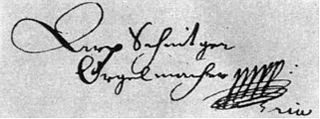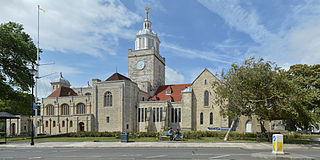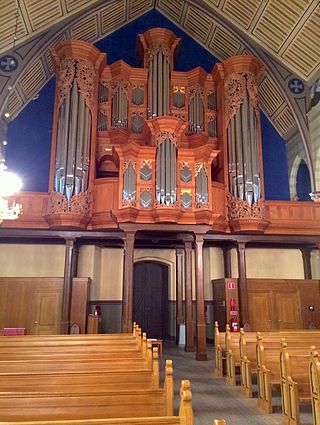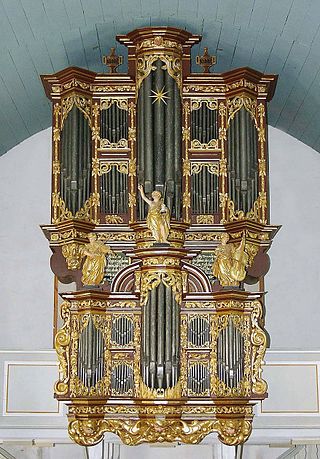
St. Raphael's Cathedral is a Catholic cathedral and a parish church in the Archdiocese of Dubuque located in Dubuque, Iowa. The parish is the oldest congregation of any Christian denomination in the state of Iowa. The cathedral church, rectory, former convent, and former parochial school building are contributing properties in the Cathedral Historic District on the National Register of Historic Places.

Arp Schnitger was an influential Northern German organ builder. Considered the paramount manufacturer of his time, Schnitger built or rebuilt over 150 organs. He was primarily active in Northern Europe, especially the Netherlands and Germany, where a number of his instruments still survive.

St Francis Xavier's Church is a Roman Catholic church in Salisbury Street, Everton, Liverpool, Merseyside, England. The church is recorded in the National Heritage List for England as a designated Grade II* listed building. It is an active parish church in the Archdiocese of Liverpool and the Pastoral Area of Liverpool North.

The Cathedral Church of St Thomas of Canterbury, commonly known as Portsmouth Cathedral, is an Anglican cathedral church in the centre of Old Portsmouth in Portsmouth, England. It is the cathedral of the Diocese of Portsmouth and the seat of the bishop of Portsmouth.

Aarhus Cathedral is a cathedral in Aarhus, Denmark. It is the longest and tallest church in the country, at 93 m (305 ft) in length and 96 m (315 ft) in height.

Rouen Cathedral is a Catholic church in Rouen, Normandy, France. It is the see of the Archbishop of Rouen, Primate of Normandy. It is famous for its three towers, each in a different style. The cathedral, built and rebuilt over a period of more than eight hundred years, has features from Early Gothic to late Flamboyant and Renaissance architecture. It also has a place in art history as the subject of a series of impressionist paintings by Claude Monet, and in architecture history as from 1876 to 1880, it was the tallest building in the world.

Lübeck Cathedral is a large brick-built Lutheran cathedral in Lübeck, Germany, and part of the Lübeck World Heritage Site. It was started in 1173 by Henry the Lion as a cathedral for the Bishop of Lübeck. It was partly destroyed in a bombing raid in World War II (1942), when the Arp Schnitger organ was destroyed by fire, but was subsequently reconstructed.

Saint Teresa of Ávila Cathedral is a cathedral in Požega, Croatia, and the seat of the Požega diocese. Located near Požega city center and at the foot of the hill where a medieval fortress once stood, this cathedral is a beautiful example of Baroque architecture.

The organ of the St. Jacobi Church in Hamburg, was built from 1689 to 1693 by the most renowned organ builder of his time, Arp Schnitger. The organ boasts four manuals and pedal with 60 stops, 15 of which are reeds – and has approximately 4000 sounding pipes. All in all, from the organ's original installation and its condition today not much of its conception has changed. The old pipework and the prospect pipes have been preserved in almost original format. It is the largest organ in existence from before 1700 and is one of the most eminent Baroque instruments that have been preserved.

Bremen Cathedral, named after St. Peter, is a church situated in the market square in the center of Bremen. The cathedral belongs to the Bremian Evangelical Church, a member of the umbrella organization Protestant Church in Germany. It is the previous cathedral of the former Prince-Archbishopric of Bremen. Since 1973, it is protected by the monument protection act.

St Luke's Church, Farnworth, Widnes, is a church in Farnworth, which was once a separate village but is now part of the town of Widnes, Cheshire, England. The church dates back to the 12th century and contains several items of historical interest, particularly hatchments and memorials. It is recorded in the National Heritage List for England as a designated Grade II* listed building, and is an active Anglican parish church in the diocese of Liverpool, the archdeaconry of Warrington and the deanery of Widnes.

The North German baroque organ in Örgryte Nya Kyrka is a pipe organ in Gothenburg. It was built within a research project at GOArt, University of Gothenburg and dedicated on August 12, 2000. The goal of the project was to recreate the construction techniques and design philosophies of 17th-century German organbuilder Arp Schnitger. Even though the instrument was built in the style of this single builder it was not modeled after a single instrument. No single model could be used since no large Schnitger organ has been preserved in original condition. The construction of the organ was carried out by an international team of organ builders. Henk van Eeken was responsible for the design and the technical drawings, Munetaka Yokota for the pipe work and Mats Arvidsson oversaw the building process. The instrument contains almost 4000 pipes and is the largest existing organ tuned in quarter-comma meantone.
Rudolf Kelber is a German organist, harpsichordist, conductor and church musician.

St. Paul's Episcopal Cathedral, is located in downtown Des Moines, Iowa, United States. It is the cathedral church of the Episcopal Diocese of Iowa. The building was listed on the National Register of Historic Places as St. Paul's Episcopal Church.

The Parish Church of St Luke, Chelsea, is an Anglican church, on Sydney Street, Chelsea, London SW3, just off the King's Road. Ecclesiastically it is in the Deanery of Chelsea, part of the Diocese of London. It was designed by James Savage in 1819 and is of architectural significance as one of the earliest Gothic Revival churches in London, perhaps the earliest to be a complete new construction. St Luke's is one of the first group of Commissioners' churches, having received a grant of £8,333 towards its construction with money voted by Parliament as a result of the Church Building Act of 1818. The church is recorded in the National Heritage List for England as a designated Grade I listed building. The gardens of St Luke's are Grade II listed on the Register of Historic Parks and Gardens.

St Luke's Anglican Church is a heritage-listed church at 152 Herries Street, Toowoomba City, Queensland, Australia. It is the second church on the site and was designed by John Hingeston Buckeridge and built in 1897. It is also known as St Luke's Church of England. It was added to the Queensland Heritage Register on 28 July 2000.

Heinz Wunderlich was a German organist, academic, and composer. He was known for playing the organ works of Max Reger. He studied in Leipzig with Karl Straube, a friend of Reger. Wunderlich worked as both a church musician and academic in Halle until 1957 when he fled to West Germany and became a church musician and academic in Hamburg. He toured internationally and attracted students from many countries to study with him in Hamburg. After retiring from teaching, he went on to more compositions.

The organ of St. Peter and Paul in Cappel was built in 1680 by Arp Schnitger for the St. Johannis-Klosterkirche in Hamburg and has been in Cappel, Lower Saxony since 1816. It is considered to be the most complete and sonically best-preserved organ from the late 17th century in northern Germany. The instrument has two manuals with pedal and 30 stops, of which only two are not entirely old. Helmut Walcha's recordings of Bach's organ works (1950–1952) made this instrument world-famous.
Gustav Fock was a German music historian, editor early music and organologist. He is considered the most important Arp Schnitger researcher of his time.
Johann Paul Geycke was a Hamburg organ builder of the 18th century.



















